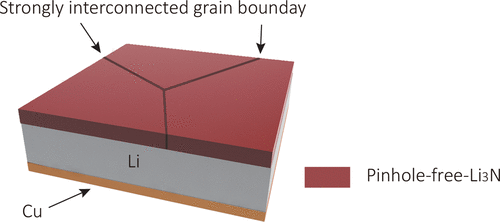当前位置:
X-MOL 学术
›
ACS Cent. Sci.
›
论文详情
Our official English website, www.x-mol.net, welcomes your
feedback! (Note: you will need to create a separate account there.)
Robust Pinhole-free Li3N Solid Electrolyte Grown from Molten Lithium
ACS Central Science ( IF 12.7 ) Pub Date : 2017-12-08 00:00:00 , DOI: 10.1021/acscentsci.7b00480 Yanbin Li , Yongming Sun , Allen Pei , Kaifeng Chen , Arturas Vailionis , Yuzhang Li , Guangyuan Zheng , Jie Sun , Yi Cui 1
ACS Central Science ( IF 12.7 ) Pub Date : 2017-12-08 00:00:00 , DOI: 10.1021/acscentsci.7b00480 Yanbin Li , Yongming Sun , Allen Pei , Kaifeng Chen , Arturas Vailionis , Yuzhang Li , Guangyuan Zheng , Jie Sun , Yi Cui 1
Affiliation

|
Lithium metal is the ultimate anode choice for high energy density rechargeable lithium batteries. However, it suffers from inferior electrochemical performance and safety issues due to its high reactivity and the growth of lithium dendrites. It has long been desired to develop a materials coating on Li metal, which is pinhole-free, mechanically robust without fracture during Li metal deposition and stripping, and chemically stable against Li metal and liquid electrolytes, all while maintaining adequate ionic conductivity. However, such an ideal material coating has yet to be found. Here we report a novel synthesis method by reacting clean molten lithium foil directly with pure nitrogen gas to generate instantaneously a pinhole-free and ionically conductive α-Li3N film directly bonded onto Li metal foil. The film consists of highly textured large Li3N grains (tens of μm) with (001) crystalline planes parallel to the Li metal surface. The bonding between textured grains is strong, resulting in a mechanically robust film which does not crack even when bent to a 0.8 cm curvature radius and is found to maintain pinhole-free coverage during Li metal deposition and stripping. The measured ionic conductivity is up to 5.2 × 10–4 S cm–1, sufficient for maintaining regular current densities for controllable film thicknesses ranging from 2 to 30 μm. This Li3N coating is chemically stable, isolating the reactive metallic lithium from liquid electrolyte, prevents continuous electrolyte consumption during battery cycling, and promotes dendrite-free uniform lithium plating/stripping underneath. We demonstrated Li|Li4Ti5O12 cells with stable and flat potential profiles for 500 cycles without capacity decay or an increase in potential hysteresis.
中文翻译:

从熔融锂中生长的无针孔的坚固耐用的Li 3 N固体电解质
金属锂是高能量密度可充电锂电池的最终阳极选择。然而,由于其高反应性和锂树枝状晶体的生长,其遭受了较差的电化学性能和安全性问题。长期以来一直期望开发一种在Li金属上的材料涂层,该材料涂层无针孔,在Li金属沉积和剥离过程中机械牢固,不破裂,对Li金属和液体电解质具有化学稳定性,同时又保持足够的离子电导率。然而,尚未找到这种理想的材料涂层。在这里,我们通过清洁熔融的锂箔直接与纯氮气的无针孔和离子导电α-Li发生反应瞬间生成报告的新的合成方法3N膜直接粘合到Li金属箔上。该膜由高度织构化的大型Li 3 N晶粒(数十微米)组成,其(001)晶面平行于Li金属表面。织纹晶粒之间的结合很牢固,从而形成了机械坚固的薄膜,即使弯曲到0.8 cm曲率半径时也不会破裂,并且发现在Li金属沉积和剥离过程中可以保持无针孔覆盖。测得的离子电导率最高为5.2×10 –4 S cm –1,足以维持可控制的2到30μm膜厚的规则电流密度。这个李3N涂层具有化学稳定性,可将反应性金属锂与液态电解质隔离,防止电池循环期间连续消耗电解质,并促进下方无树突的均匀锂电镀/剥离。我们证明了Li | Li 4 Ti 5 O 12电池在500个循环中具有稳定且平坦的电势曲线,而容量没有下降或电势滞后增加。
更新日期:2017-12-08
中文翻译:

从熔融锂中生长的无针孔的坚固耐用的Li 3 N固体电解质
金属锂是高能量密度可充电锂电池的最终阳极选择。然而,由于其高反应性和锂树枝状晶体的生长,其遭受了较差的电化学性能和安全性问题。长期以来一直期望开发一种在Li金属上的材料涂层,该材料涂层无针孔,在Li金属沉积和剥离过程中机械牢固,不破裂,对Li金属和液体电解质具有化学稳定性,同时又保持足够的离子电导率。然而,尚未找到这种理想的材料涂层。在这里,我们通过清洁熔融的锂箔直接与纯氮气的无针孔和离子导电α-Li发生反应瞬间生成报告的新的合成方法3N膜直接粘合到Li金属箔上。该膜由高度织构化的大型Li 3 N晶粒(数十微米)组成,其(001)晶面平行于Li金属表面。织纹晶粒之间的结合很牢固,从而形成了机械坚固的薄膜,即使弯曲到0.8 cm曲率半径时也不会破裂,并且发现在Li金属沉积和剥离过程中可以保持无针孔覆盖。测得的离子电导率最高为5.2×10 –4 S cm –1,足以维持可控制的2到30μm膜厚的规则电流密度。这个李3N涂层具有化学稳定性,可将反应性金属锂与液态电解质隔离,防止电池循环期间连续消耗电解质,并促进下方无树突的均匀锂电镀/剥离。我们证明了Li | Li 4 Ti 5 O 12电池在500个循环中具有稳定且平坦的电势曲线,而容量没有下降或电势滞后增加。







































 京公网安备 11010802027423号
京公网安备 11010802027423号